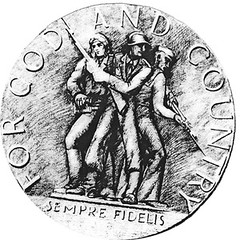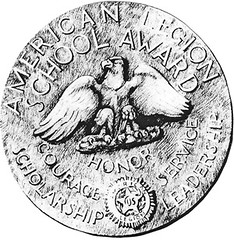
PREV ARTICLE
NEXT ARTICLE
FULL ISSUE
PREV FULL ISSUE
JOSEPH EMILE RENIER (1887-1966)As noted in the previous article in this E-Sylum issue, researcher Harry Waterson published further information on the American Legion School Award medals, the latest being a
piece published in the October 2016 issue of The Clarion from the Pennsylvania Association of Numismatists. With permission here is an excerpt from that article concerning sculptor Joseph
Emile Renier and the 1950 ALSA medal. Thanks! -Editor
Medallic Art Company (MACo) hired Joseph E. Renier to make the models for the Morris medal. Renier was born in Union City, NJ in 1887 and he received his early art education at the Art Students League in New York. He later studied under M. Victor Rousseau in Brussels and at the American Academy in Rome. In World War I he served with the American Red Cross and he received a commendation from the Italian Government for his work at the wartime settlement at Monteporzio in the Sabine Hills near Rome. Joseph Renier is most well known for his heroic-size group Speed at the 1939 World's Fair in NYC. For 14 years Renier was an Associate Professor of Life Drawing at the Yale Fine Arts School. He also taught architectural drawing at New York University (NYU) for several years. He designed the Civil War Centennial Medal in 1961 and the Mark Hopkins Medal for the NYU Hall of Fame for Great Americans series. He modeled medals for the American Heart Association and the VFW. Renier. himself, was the recipient of many awards, The Samuel F. B. Morse Medal, the Elizabeth N. Watrous Gold Medal and the Daniel Chester French Medal of the National Academy of Design. Renier was a sculptural traditionalist and was on the Medallic Art Company short list of favored medallists. In 1950 at the behest of MACo Renier produced these designs for a new American Legion School Award.   These sketches did not find favor with Carlos Morris. He was the Director of American Legion Emblem Sales and in 1950 he submitted the design of the new School Award for US Patent protection and Morris listed himself as the inventor on the patent application. Clyde Trees of Medallic Art returned them to Renier on September 8, 1950 with this note: "They have decided to handle the design for their pieces through a local artist and it will be purely a commercial item. They will not use sculptured designs such as we have prepared." On October 11, Renier got the purchase order for the new School Award. "Please proceed with the obverse and reverse models for the American legion as per their design. Make these 10" in diameter. The relief to be the same as the Old American Legion models made by R. Tait McKenzie. The obverse: as we discussed it, the border where the inscription is around is flat and from there, there is a slight convex curvature, not too great, and that will give the appearance of the figures of the soldiers to be of higher relief than they would be on a flat surface. You are to follow the details on the drawing texturely (sic) and make no change whatever from their conception. This holds good for both obverse and reverse." Joseph Renier rendered his invoice to Medallic Art on October 27, 1950: $300 for the American Legion medal as per drawing submitted. It is too bad the 'local artist' was not identified in the note from Clyde Trees to Joseph Renier. There is still a question whether Carlos Morris was the actual designer or an Indianapolis artist drew up the design to Morris' specifications. In any case this design is credited to Carlos Morris in this article. In 1951 the new School Award medal was struck along with the accompanying pin of the reverse or a stand-alone hanging badge. Joseph Renier did an excellent job of recreating the Morris design in bas-relief. This medal in various iterations had a 23 year run. Harry Waterson adds: This article is the latest of three I have written so far about the ALSA. There was a second article in JOMSA, the Journal of the Orders and Medals Society of America entitled “The American Legion School Award, An Educational Progression” in the Nov.-Dec. 2014 issue. Harry's dogged work researching American medals is shedding much light on previously overlooked and underappreciated numismatic items. Some are rare, many are relatively common,
but all have interesting stories of their own that might remain unknown otherwise. Keep up the great work! -Editor
THE BOOK BAZARREWayne Homren, Editor The Numismatic Bibliomania Society is a non-profit organization promoting numismatic literature. See our web site at coinbooks.org. To submit items for publication in The E-Sylum, write to the Editor at this address: whomren@gmail.com To subscribe go to: https://my.binhost.com/lists/listinfo/esylum All Rights Reserved. NBS Home Page Contact the NBS webmaster 
|